
Water Pressure Reducing Valve
There are various types of Self Actuating Type Pressure Reducing Va... upon the working Pressures, Flow Rates and Fluids.Self Acting, Pilot & Piston operated Reducing Valves are more Pressure Reduction of STEAM in all types of industries. The Valve Spring Balance principal. The Downstream Pressure is Sense Diaphragm Which is balanced by the Spring Tension. Increasing sp... Increases Outlet Pressure and Vice Versa.
...more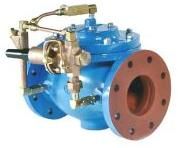
Surge Control Valve
Flow-TekSurge Anticipator Valve is indispensable for protecting pumps, pumping equipment and all applicable pipelines from dangerous pressure surges caused by rapid changes of flow velocity within a pipeline. When using this valve, pumping systems are started and stopped gradually preventing harmful surges from occurring. Pressure Relief & Surge Anticipator Valve
...more
STRAIGHT TYPE DELUGE VALVE
FLOW TEK DELUGE VALVE are intended to deliver large quantities of water over a large area in a relatively short period of time. The flow tek Deluge Valve is UL approved to 250 psi G. (17.5 bar) in sizes 2", 2½", 3", 4", 6", 8", 10", (50,65,80, 100, 150,200 & 250 MM ). The FLOW AGE deluge Valve is compact, lightweight, and is provided with a preassembled trim - all of which minimize the installation time and make it simple and easy. The FLOW AGE Valve opens fast, yet smoothly, preventing water hammer. The FLOW AGE Valve design prevents false tripping and it can be reset by a thumb-activated knob. STRAIGHT TYPE DELUGE VALVE DETAIL -UL Listed Local Resetting - Once the deluge valve operates, it is latched in an open position Remote Resetting - The FLOW TEK Deluge Valve can be remotely reset. The FLOW TEK Deluge Valve is designed to allow for a variety of detection and release systems: Hydraulic Actuation ( WET PILOT TRIM) Wet pipe systems are the most common fire sprinkler system. A wet pipe system is one in which water is constantly maintained within the sprinkler piping. When a sprinkler activates this water is immediately discharged onto the fire. Advantages to using a wet pipe fire sprinkler system include: System simplicity and reliability - Wet pipe sprinkler systems have the least number of components and therefore, the lowest number of items to malfunction. This produces unexcelled reliability which is important since sprinklers may be asked to sit in waiting for many years before they are needed. This simplicity aspect also becomes important in facilities where system maintenance may not be performed with the desired frequency. Relative low installation and maintenance expense - Due to their overall simplicity, wet pipe sprinklers require the least amount of installation time and capital. Maintenance cost savings are also realized since less service time is generally required compared to other system types. These savings become important when maintenance budgets are shrinking. Ease of modification - Wet pipe fire sprinkler systems are advantageous since modifications involve shutting down the water supply, draining pipes and making alterations. Following the work, the system is pressure tested and restored. Additional work for detection and special control equipment is avoided which again saves time and expense. Short term down time following a fire - Wet pipe sprinkler systems require the least amount of effort to restore. In most instances, sprinkler protection is reinstated by replacing the fused sprinklers and turning the water supply back on. Pre-action and dry-pipe systems may require additional effort to reset control equipment. Disadvantages to using a wet pipe fire sprinkler system include: Wet pipe systems are not suited for sub-freezing environments. There may also be a concern where piping is subject to severe impact damage and could consequently leak. Pneumatic Actuation (DRY PILOT TRIM) A dry pipe sprinkler system is one in which pipes are filled with pressurized air or nitrogen, rather than water. This air holds a remote valve, known as a dry pipe valve, in a closed position. Located in a heated space, the dry-pipe valve prevents water from entering the pipe until a fire causes one or more sprinklers to operate. Once this happens, the air escapes and the dry pipe valve releases. Water then enters the pipe, flowing through open sprinklers onto the fire. Advantages of using dry pipe fire sprinkler systems include: Dry pipe sprinkler systems provide automatic protection in spaces where freezing is possible. Typical dry pipe installations include unheated warehouses and attics, outside exposed loading docks and within commercial freezers. Many people view dry pipe sprinklers as advantageous for protection of collections and other water sensitive areas. This perceived benefit is due to a fear that a physically damaged wet pipe system will leak while dry pipe systems will not. In these situations, however, dry pipe systems will generally not offer any advantage over wet pipe systems. Should impact damage happen, there will only be a mild discharge delay, i.e. 1 minute, while air in the piping is released before water flow. Disadvantages of using dry pipe fire sprinkler systems include: Increased complexity - Dry pipe systems require additional control equipment and air pressure supply components which increases system complexity. Without proper maintenance this equipment may be less reliable than a comparable wet pipe system. Higher installation and maintenance costs - The added complexity impacts the overall dry-pipe installation cost. This complexity also increases maintenance expenditure, primarily due to added service labor costs Lower design flexibility - There are strict requirements regarding the maximum permitted size (typically 750 gallons) of individual dry-pipe systems. These limitations may impact the ability of an owner to make system additions. Increased fire response time - Up to 60 seconds may pass from the time a sprinkler opens until water is discharged onto the fire. This will delay fire extinguishing actions, which may produce increased content damage. Increased corrosion potential - Following operation, dry-pipe sprinkler systems must be completely drained and dried. Otherwise remaining water may cause pipe corrosion and premature failure. This is not a problem with wet pipe systems where water is constantly maintained in piping. With the exception of unheated building spaces and freezer rooms, dry pipe systems do not offer any significant advantages over wet pipe systems. Electric Actuation VALVE WILL BE OPERATED BY SOLENOID VALVE, WHICH WILL BE OPERATED BY ANY POWER SUPPLY 220 V , 230 V , 24 V DC, ETC..
...more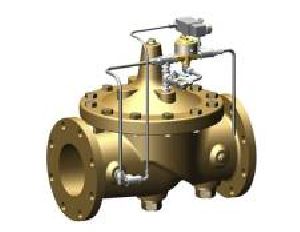
Solenoid Control Valve
Flow-Tek ACV Solenoid Control Valve with Hydraulic Check Feature is designed to open fully or close drip-tight as commanded by a 3-Way Solenoid Pilot, and close drip-tight when downstream pressure becomes greater than upstream pressure. The solenoid may be activated by a pressure switch, level probe, or any other electrical on-off device. The valve also has provisions for manual operation in the event of power outage. Engaging the Solenoid Manual operator simulates power to the solenoid, manually controlling the main valve. Disengaging the Solenoid Manual operator returns the valve to electrical on-off service.
...more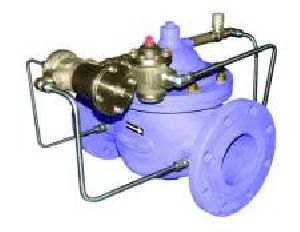
Slug Control Valve
Flow-Tek slug valve is special Fuel system valve designed for use on the discharge of filter separator.Working in conjunction with any of Flow tek series interface float pilots and Performing function:- 1. Opens to allow fuel flow when there is little or no water in the sump of the filter separation 2. Closes tightly to prevent flow when high water level is reached.
...more
PRESSURE REDUCING VALVE FOR STEAM
"Flow-Tek" Self Acting, Pilot & Piston operated Pressure Reducing Valves are most popular for pressure reduction of STEAM in all types of Industries. The Valve operates on Spring Balance principle.The Downstream pressure is sensed below stainless steel diaphragm which is balanced by the spring tension. Increasing spring tension, increases outlet pressure and vice versa. The Valve has additional external Sense Line provision also, which improves performance and accuracy of outlet pressure.
...more
Piston Type Digital Control Valve
Flow-Tek This is an electrically actuated, hydraulically operated multi-function control valve. Used extensively in loading terminal automation systems in refineries and storage tanks of petroleum products for effective and accurate filling of tankers and railway wagons. It has two solenoid valves, receiving signal from batch controllers to position the valve for low flow/medium flow / high flow conditions as programmed.
...more
Non Return Valve
Flow-Tek The Float Valve is a non-modulating either fully open or fully closed valve which controls the level in a reservoir or tank. The valve closes drip tight at high liquid level point and opens fully when the liquid level reaches a low preset point.
...more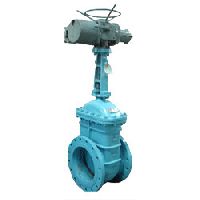
Motorized gate valve
Gate Valves OS & Y Type, Rising Spindle, Construction are the most commonly used ON - OFF Valve in the Industries today. This Bi-Directional ON-OFF Gate Valves are widely used where the minimum Pressure Drop is required.Gate Valves are Tight Sealing easy Operation & Isolation Valve widely used for Steam, Liquid & Gaseous Fluid over a wide Range of Line Pressure & Temp.
Size : 1/2" to 28"
...more
LOW PRESSURE REDUCING VALVE
"Flow-Tek" Balanced Plug Gas Pressure Regulator is the ideal valve for low pressure gas regulation with higher inlet pressures.The self-contained, low-pressure gas regulator is for use on tank blanketing, gas meter inlet pressure regulating, gas burners and other low-pressure air and gas applications. The valve has a 360° orientation, can be installed in any position, and can be easily repositioned while in line. The seat and plug can be inspected without removing body from the line. Design Standard : MFG. STANDARD Face to Face : MFG .STANDARD End Connection : Flanged End to suit ANSI / DIN / BS / JIS / IS etc. Testing Standard : API 598 / CONTROL VALVE ANSI-FCI-70-2-2006 STD
...more
jacketed valves
Flush Bottom Valves Opening Option: Inside Vessels or Inside Valve opening. Available in the size from 15 MM to 150 MM with different material of construction like Cast Iron, Cast Steel, SS 304 316 or any special alloy to suit user requirements. Also available in Jacketed Design & Teflon lined Design.
...more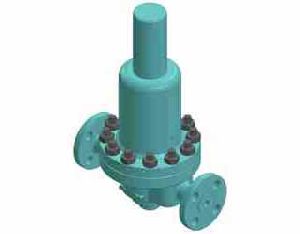
HIGH PRESSURE REDUCING VALVE
"Flow-Tek" is designed primarily for high pressure steam service commonly found in power plants, refineries, pulp and paper mills, and other high pressure process applications. Since high pressure superheated steam is routinely used for power generation (turbines), a pressure regulator capable... APPLICABLE STANDARD Design Standard : MFG. STANDARD Face to Face : MFG .STANDARD End Connection : Flanged End to suit ANSI / DIN / BS / JIS / IS etc. Testing Standard : API 598 / CONTROL VALVE ANSI-FCI-70-2-2006 STD
...more
Gas Pressure Regulator
"Flow-Tek" FT-LPRV- Gas Back Pressure Regulator is the ideal valve for low-pressure gas regulation. The FT LPRV works in conjugation with the in a low-pressure tank blanketing valve system.LPRV can be used to vent gas from the tank to prevent the blanketing pressure from rising to a level that could damage the tank while maintaining a small, constant flow to keep the blanket fresh. During filling, It opens to allow gas to escape as the vapor space in the tank grows smaller. To size properly, find the rate of fill so that a regulator can be chosen based on it's ability to relieve the required amount of gas while sustaining desired blanketing pressure. The Mark 508 will also work well in any other type of low back-pressure gas application. APPLICABLE STANDARD Design Standard : MFG. STANDARD Face to Face : MFG .STANDARD End Connection : Flanged End to suit ANSI / DIN / BS / JIS / IS etc. Testing Standard : API 598 / CONTROL VALVE ANSI-FCI-70-2-2006 STD
...more
GAS BLANKETING VALVE
"Flow-Tek" FT-LPRV- Gas Back Pressure Regulator is the ideal valve for low-pressure gas regulation. The Mark 508 works in conjugation with the in a low-pressure tank blanketing valve system.LPRV can be used to vent gas from the tank to prevent the blanketing pressure from rising to a level that could damage the tank while maintaining a small, constant flow to keep the blanket fresh. During filling, It opens to allow gas to escape as the vapor space in the tank grows smaller. To size properly, find the rate of fill so that a regulator can be chosen based on it's ability to relieve the required amount of gas while sustaining desired blanketing pressure. The Mark 508 will also work well in any other type of low back-pressure gas application. APPLICABLE STANDARD Design Standard : MFG. STANDARD Face to Face : MFG .STANDARD End Connection : Flanged End to suit ANSI / DIN / BS / JIS / IS etc. Testing Standard : API 598 / CONTROL VALVE ANSI-FCI-70-2-2006 STD
...more
Digital Control Valve
Flow-Tek This is an electrically actuated, hydraulically operated multi-function control valve.Used extensively in loading terminal automation systems in refineries and storage tanks of petroleum products for effective and accurate filling of tankers and railway wagons. It has two solenoid valves, receiving signal from batch controllers to position the valve for low flow/medium flow / high flow conditions as programmed.
...more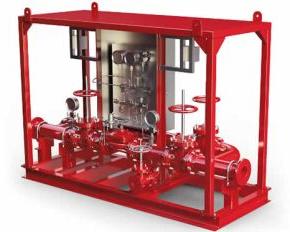
Deluge Valve Skid
Deluge Valve Skid professionally pre-assembled, factory tested deluge valve systems UL Listed modular package for quick and convenient installation Comes with downstream, upstream and bypass butterfly valves Pressure switch, solenoid valve mounted, pre-wired & terminated into junction box Can be custom designed and manufactured Cost effective and reduced installation time
...more
ANGLE TYPE
Deluge Systems are intended to deliver large quantities of water over a large area in a relatively short period of time. The FLOW TEK Deluge Valve is UL approved to 175 psi (12 bar) in sizes 3", 4", 6", (80, 100, 150,MM ). The FLOW AGE deluge Valve is compact, lightweight, and is provided with a preassembled trim - all of which minimize the installation time and make it simple and easy. The FLOW TEK Valve opens fast, yet smoothly, preventing water hammer. The FLOW TEK Valve design prevents false tripping and it can be reset by a thumb-activated knob. Local Resetting - Once the deluge valve operates, it is latched in an open position. Remote Resetting - The FLOW TEK Deluge Valve can be remotely reset. Hydraulic Actuation (WET PILOT TRIM) Wet pipe systems are the most common fire sprinkler system. A wet pipe system is one in which water is constantly maintained within the sprinkler piping. When a sprinkler activates this water is immediately discharged onto the fire. Advantages to using a wet pipe fire sprinkler system include: System simplicity and reliability - Wet pipe sprinkler systems have the least number of components and therefore, the lowest number of items to malfunction. This produces unexcelled reliability which is important since sprinklers may be asked to sit in waiting for many years before they are needed. This simplicity aspect also becomes important in facilities where system maintenance may not be performed with the desired frequency. Relative low installation and maintenance expense - Due to their overall simplicity, wet pipe sprinklers require the least amount of installation time and capital. Maintenance cost savings are also realized since less service time is generally required compared to other system types. These savings become important when maintenance budgets are shrinking. Ease of modification - Wet pipe fire sprinkler systems are advantageous since modifications involve shutting down the water supply, draining pipes and making alterations. Following the work, the system is pressure tested and restored. Additional work for detection and special control equipment is avoided which again saves time and expense. Short term down time following a fire - Wet pipe sprinkler systems require the least amount of effort to restore. In most instances, sprinkler protection is reinstated by replacing the fused sprinklers and turning the water supply back on. Pre-action and dry-pipe systems may require additional effort to reset control equipment. Disadvantages to using a wet pipe fire sprinkler system include: Wet pipe systems are not suited for sub-freezing environments. There may also be a concern where piping is subject to severe impact damage and could consequently leak. Pneumatic Actuation (DRY PILOT TRIM) A dry pipe sprinkler system is one in which pipes are filled with pressurized air or nitrogen, rather than water. This air holds a remote valve, known as a dry pipe valve, in a closed position. Located in a heated space, the dry-pipe valve prevents water from entering the pipe until a fire causes one or more sprinklers to operate. Once this happens, the air escapes and the dry pipe valve releases. Water then enters the pipe, flowing through open sprinklers onto the fire. Advantages of using dry pipe fire sprinkler systems include: Dry pipe sprinkler systems provide automatic protection in spaces where freezing is possible. Typical dry pipe installations include unheated warehouses and attics, outside exposed loading docks and within commercial freezers. Many people view dry pipe sprinklers as advantageous for protection of collections and other water sensitive areas. This perceived benefit is due to a fear that a physically damaged wet pipe system will leak while dry pipe systems will not. In these situations, however, dry pipe systems will generally not offer any advantage over wet pipe systems. Should impact damage happen, there will only be a mild discharge delay, i.e. 1 minute, while air in the piping is released before water flow. Disadvantages of using dry pipe fire sprinkler systems include: Increased complexity - Dry pipe systems require additional control equipment and air pressure supply components which increases system complexity. Without proper maintenance this equipment may be less reliable than a comparable wet pipe system. Higher installation and maintenance costs - The added complexity impacts the overall dry-pipe installation cost. This complexity also increases maintenance expenditure, primarily due to added service labor costs. Lower design flexibility - There are strict requirements regarding the maximum permitted size (typically 750 gallons) of individual dry-pipe systems. These limitations may impact the ability of an owner to make system additions. Increased fire response time - Up to 60 seconds may pass from the time a sprinkler opens until water is discharged onto the fire. This will delay fire extinguishing actions, which may produce increased content damage. Increased corrosion potential - Following operation, dry-pipe sprinkler systems must be completely drained and dried. Otherwise remaining water may cause pipe corrosion and premature failure. This is not a problem with wet pipe systems where water is constantly maintained in piping. With the exception of unheated building spaces and freezer rooms, dry pipe systems do not offer any significant advantages over wet pipe systems. Electric Actuation VALVE WILL BE OPERATED BY SOLENOID VALVE, WHICH WILL BE OPERATED BY ANY POWER SUPPLY 220 V , 230 V , 24 V DC, ETC Pneu-Electric Actuation ALSO SOLENOID VALVE WILL BE CONNECTED IN PNUEMATIC CONNECTION Deluge Valve Model FTV-ACV-200 (ANGLE TYPE) 90 Degree Fast application of water in spray, pre-action and foam system Size: 50, 80, 100, 150 & 200 mm (2", 3", 4", 6" & 8") Cast Iron , CAST STEEL ,and Alloy Steel construction Maximum service pressure 12 bar (175 psi) Vertical inlet and Horizontal outlet SS 304 , SS 316, Bronze Seat Flanged connection dimensions to ANSI B 16.5 No latch, no piston, no hinges Simple yet rugged Diaphragm operated with rubber to metal drip-tight positive sealing Reset without any tools Easily trimmed for actuation by manual, remote solenoid valve & with wet or dry pilot Internal and external surfaces epoxy coated for extra protection The Deluge Valves are also available as pre-assembled cabinet/skid mounted, upon request With the exception of unheated building spaces and freezer rooms, dry pipe systems do not offer any significant advantages over wet pipe systems.
...more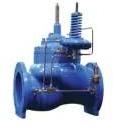
altitude valve
Flow-Tek The Single Acting Altitude Control Valve closes at a preset maximum water level to prevent overflow of a ground storage tank or reservoir and opens to refill when the water level in the tank or reservoir lowers. This type of Altitude Control Valve should be used when the supply pressure is appreciably higher (15 psi+) than the head developed by a full ground storage tank or reservoir. An altitude control valve controls the level of a tank. The altitude valve will remain open while the tank is not full and it will close when the tanks reaches its maximum level. The opening and closing of the valve requires no external power source (electric, pneumatic, or man power), it is done automatically, hence its name.
...more
automatic control valve
Our Automatic Control Valves regulates the flow or pressure of different fluids, efficiently. These Automatic Valves are preferred owing to their high strength, reliability and smooth functioning.
...more
pneumatic operated control valves

Pulp Valves

Flush Bottom Valves

Blow Down Valves

automatic control valves
Flow-Tek Valves & Controls A leading Manufacturer of Specialized Control Valves offers a self Actuating Pilot Operated Automatic Control Valve specially design for Liquid Service, Also called as a 'Multifunction' Control Valve. These type of Valves are designed to provide different combination of Pilot Arrangements that can be used for various types of functions like : OnOff, Pressure Reducing, Pressure Relief, Flow Control, Pump Bypass, Non Return & many more. Flow-Tek Liquid Controls Valves confirms the seat leakage in Class VI of ANSI B 16.104 & available up to size of 16" in the flanged end to ANSI Class 150 & 300 with temperature range up to 220' C maximum.
Pressure Rating : ASA 150#, 300#
...moreBe first to Rate
Rate ThisOpening Hours